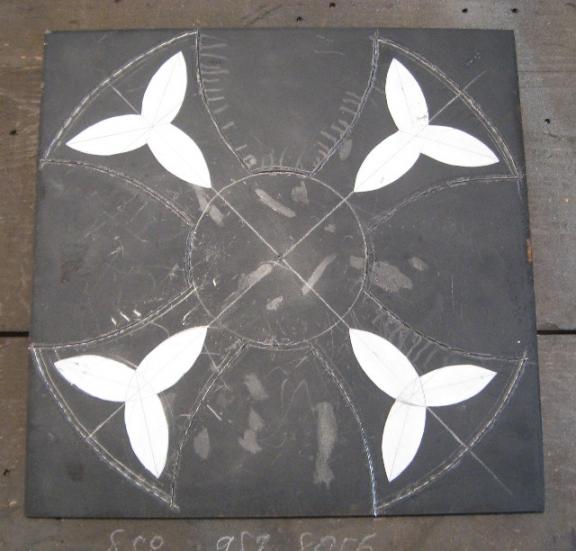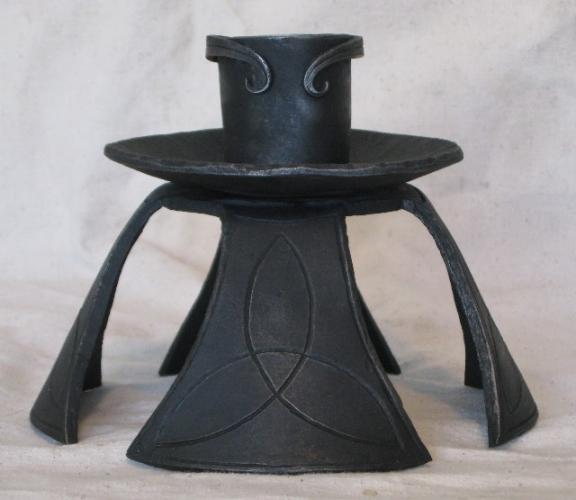
Gerald Boggs
-
Posts
1,198 -
Joined
-
Last visited
Content Type
Profiles
Forums
Articles
Gallery
Downloads
Events
Posts posted by Gerald Boggs
-
-
Yep, the steel supplier near Touchstone in Pennsylvania does that, just has hot and cold A36
-
If I had it to do over, I would just use my name: Gerald Boggs, blacksmith. Wayfarer Forge just makes folks have to remember two names instead of one. I'm getting ready to order more jewelry boxes with a name impression, it was "Wayfarer Forge" Now it's going to be "Gerald Boggs" top line and "Blacksmith" second line.
-
On 2/23/2013 at 4:07 PM, Rich Hale said:
THe difference between cold rolled and hot rolled is how it is made into sellin shapes,,,,and Cold rolled is higher priced. when you heat cold rolled it becomes the same as hot rolled but you paid more........And I have to say,,,how could you not find the sectioon called " knife making classes"?
Depends on your location, I'm lucky here in Virginia, lots of small and large industries, so the steel suppliers are excellent My steel distributor, A36 almost always hot rolled and cold rolled is always 1018. Agree for general use as blacksmith, not much advantage to paying for cold rolled, unless you're doing fine detailed work and don't want to find out half way through that you've got a piece of junk with the A36. I once had a 20 foot piece of 1 by 1/2 A36 with a crack down the entire length, didn't show up until you had it hot. You'll never get a piece of 1018 with that.
Tom Latane always uses 1018 for his fine chisel works, that's where I picked up the habit.
-
From Starting Strength, the rack Mark rippitoe uses and recommends.
http://startingstrength.com/files/starting_strength_rack.pdf
-
Frosty and JLP, you guys are kinder, more nurturing then I am, I'm more of a 'March or Die" .
-
They don't advertise, because they don't need to. Back when I worked for others, every time we would turn around, somebody was walking into the shop looking for work. If you want to get a job, that's what you need to do. Now that I think of it, every job I ever had, was because I walked into a man's shop and asked for a job.
As for the number of shops with employees, in my area, Charlottesville, VA, there are no less then three shops with employees, and that's just the shops using the word "blacksmith"
-
"commercially available scrolling jig fixture.............Epic Fail. It is trash" You're right, if that's suppose to be a scrolling jig, it fails the sight test. Consider making your own, draw it out on an piece of sheet steel and then make exactly the scroll you want to reproduce, it is well worth the effort. As Alan wrote, the Cosira books show how.
Starting in a blacksmith/fab shop, we made and used scrolling jigs all the time, we had over 50-100 of them, yet we still needed to make new ones for a third the jobs.
-
Curious, you've been a member of CBA and active with the group, why not try getting a job with one of the many professionals that are also active with CBA? Between CBA and NWBA, there must be 100's of shops taking on employees. And most of them (99%) are not members of this forum, so if they're looking, they won't fine you.
-
Thank you for posting
-
How about now?
-
Maybe and maybe not, that church I did the work for a few years ago, was quite adamant that the work all be done as if it was done at the time the church was built. Which was 200 years ago. The Advent chandelier and candle stands were all done with a hand chisel. It all comes down to what the client wants, better to have both to offer.
From plate to finished stand
-
22 hours ago, Alan Evans said:
Sorry to hear that. And a bit surprised. I thought we were just discussing the OP's theme of how do you know which book is correct.
Maybe you missed the bit where I said I agree with you that it is the best we have got.
Alan
You're right and I apologize, that was completely out of bounds. My mother recently died and I find myself a bit short tempered this days. I though you were trolling and lashed out. Again, my apologizes
-
6 hours ago, Alan Evans said:
No, just trying to make the same point. Healthy scepticism. We should not blindly accept something simply because it appears in print, however worthy the tome.
From a position of ignorance how do we know what sources are correct? If the writers of the reference or textbook consulted the wrong practitioner or incorrectly recorded the researchers' or practitioners' experience, how can we know?
Philosophically we know that in "physics" a model is constructed which fits the observed phenomena and that is taken as the hypothesis until evidence is found to the contrary, when a new model which takes account of the new evidence is devised to replace the previous one.
All we can do is keep an open mind and build our individual world view from the information we acquire, and subsequently accept or reject.
This thread is a case in point....if you follow the various bits of quenching and quenchant information arriving in sequence it is only after a fair bit of conjecture that a consensus was formed. If you stopped reading early on although the information was not incorrect it was certainly incomplete.
Alan
All I wrote, was that a textbook was a better source for information then an unqualified source. I have no idea as to what you trying to say and frankly I don't care.
Edited
-
Now you're just splitting hairs.
-
20 hours ago, Alan Evans said:
It is all fraught with danger though...people that write reference books are not always practicing or practical people. They make mistakes. I even know of two well respected practitioners in this field that have made mistakes when it came to putting their knowledge in print.
I agree though it is the best we have got.
Alan
True, but starting with a textbook as opposed to getting your information from an unqualified source, will give you a much stronger learning base and curve.
-
9 hours ago, Andres Bello said:
And I am really interested in this topic, since I had always assumed without questioning that brine was faster, just because I've seen it in posts here over and over again. To actually challenge this (and get to a final statement) is quite important, in my opinion. Can I keep my belief (backed by facts now), or is this still in doubt?
This is my favorite book for first time readers of metallurgy, "Metallurgy fundamentals" by Daniel A. Brandt. It's an easy read, but still covers the subject quite well. Copies of it are in all four of my local libraries so I'm guessing it's an easy find in the US, but Argentina might be a different story.
-
Brent Bailey is my go to guy for hammers. I make everything else, but my hammers I get from Brent.
-
15 hours ago, SReynolds said:
Two popular smithing books. Two different opinions on technical information. I thought technical info is cut and dry. Not opinion.
So one smith says salt brine cools the work quicker than water. Another says cools slower than water.
I was asking a well known smith a technical question and when I asked him to clearify he replied that I take information too literally. So I have been thinking about that today.
What technical information should we take literally and what should we pass off as opinion?
The problem is not differences in opinion, but rather differences in knowledge. One smith can be quite knowledgeable and the other just a good talking. If one wants to understand something, one should go to the reference material. In this case a textbook on metallurgy, not only will the answer be there, the why will also be there.
-
On 2/16/2017 at 6:46 PM, rockstar.esq said:
If it's at all possible for you to find a successful blacksmith shop that does what you're interested in it would be incredibly helpful for you to intern with them.
That's a hard trick, not many shops are successful, most blacksmiths have a spouse working a job that does the actual supporting. And of the one's I know that are successful, we're mostly one-man shops with no interest in having someone in the shop. And even if I was, it wouldn't be someone with little or no skills. If someone wants to become a blacksmith by the way of working in others shops, then that person needs to show up with some basic shop skills, highest on the list would be welding. That's what I was told to do and what I did. As the smith told me, "if you know how to weld, than I can make use of you and you get a chance to learn some smithing", it worked out quite well for me. Over the years, I've given this same advice to many and not once was it acted upon.
Add to the list: solid math skills, etc.
-
Functionality.
-
What is going on? Something I've noticed for some time, crappy tongs. I see folks make beautiful stuff but can't be bothered to make a proper set of tongs to do the work. Don't folks realize how much easier the work would be, how much more they could do, if the tongs fit the task? This inconsistency between the work and the tools people will use boggles my mind.
I have never in my career, made a poor tool, I always made tools to the level as my skill allowed. So while not all my tools would be called "good" , they were the best I could do.
-
As someone that has forged and sold over 10,000 openers with last 5 years, simple is best With the exception of the Wizard which is a good demo piece.
-
My two cents and it's based on the fact that by doing this program I'm stronger now at 56 then I was at 30, and remember when I was 30, I was a paratrooper: Do the Starting Strength novice program. When I did it, I went from squatting 115 to 315 in less then nine months.
There's a lot more to it the just this, but here's the bones of the program: http://startingstrength.com/get-started/programs
-
On 12/9/2016 at 8:46 AM, Latticino said:
- Is your bracelet mandrel wood or metal, and is it tapered or cylindrical and stepped?
- Do you do the final sizing hot or cold? If hot, doesn't that eat up the leather mallet?
Like Thomas' mine is metal, oval and tapered, it has a base that fits into a stake table or vice. I got it from one of the jewelry supply companies.
As a rule, I size and shape hot, but check cold. I've done enough to have a fair idea how much far down the mandrel to go so they are the correct size when cold. If I'm off, it's easy enough to do small adjustments cold. Yes, the leather burns, but I'm not holding it against the hot iron, only lightly hammering. My current mallet has see hundreds of uses and is still 90%


Identify wrought iron
in Blacksmithing, General Discussion
Posted
For those that think wrought iron doesn't pit.